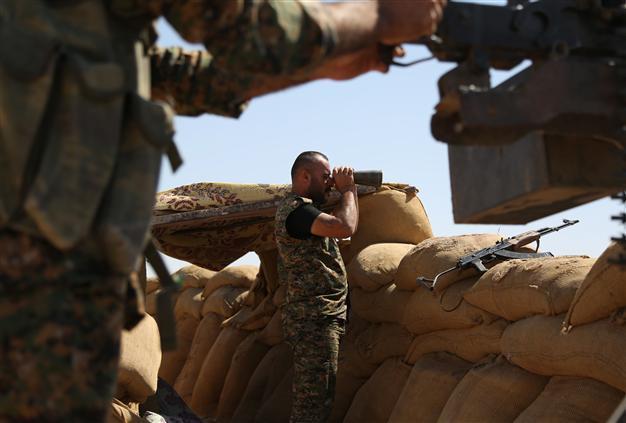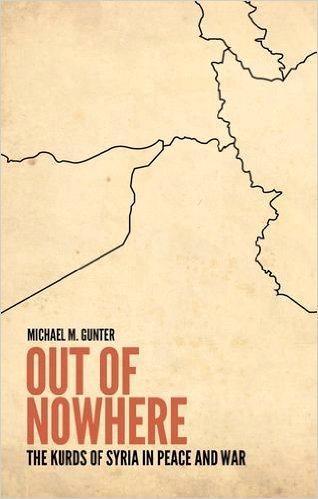Out of nowhere: The Kurds of Syria
William Armstrong - william.armstrong@hdn.com.tr
 ‘Out of Nowhere: The Kurds of Syria in Peace and War’ by Michael M. Gunter (Hurst, 176 pages, £30)
‘Out of Nowhere: The Kurds of Syria in Peace and War’ by Michael M. Gunter (Hurst, 176 pages, £30)Before 2012, the Kurds living in Syria were virtually invisible. Although they made up the country’s largest ethnic minority with a population of around 2.2 million, their Kurdish kin in Iraq, Turkey and Iran had a much higher international profile. All that changed after Syria’s war broke out in 2011. From being a sleepy backwater in the Kurdish struggle, the country suddenly became a center of resurgent Kurdish nationalism. The Kurdish PYD in northern Syria has become one of the U.S.’s closest allies in the campaign against ISIS. At the same time, Syria itself has descended into the biggest geopolitical catastrophe in a generation - a vortex sucking in all outside powers pursuing their own national interests.

“Out of Nowhere: The Kurds of Syria in Peace and War” by Professor Michael Gunter, one of the foremost scholars of the subject, is therefore very timely. The situation across Turkey’s 900-km border with Syria is in constant violent flux, so writing such a book is like nailing jelly to a wall. Gunter did his research before ISIS rose to take over much of northern Syria, waging war with the Kurds living in three non-contiguous areas, but this is still an informative and balanced volume.
It starts with an account of the post-First World War settlement, which is currently unravelling amid the regional meltdown. The Treaty of Sevres imposed by the European powers after the Ottoman Empire’s collapse left the status of the Kurds ambiguous, while the Treaty of Lausanne after the Turkish War of Independence left them entirely stateless: The world’s largest stateless nation. The Kurds would henceforth be divided between Turkey, Iraq, Syria and Iran (modern state borders that are today often dismissed as “artificial” - perhaps the only thing that Kurdish nationalists and ISIS jihadists agree on).
According to Gunter, over the past century the Kurds in Syria have struggled “under a form of sequential triple colonialism: first, the Ottoman Empire until 1918; then the French until 1946; and subsequently the Arabs once Syria gained its independence.” Of these, “it might be argued that assimilationist and denialist Arab colonialism has most exploited the Kurds in Syria.” After 1946, hundreds of thousands of “ajanib” and “maktoumeen” were entirely denied Syrian citizenship. Around 20 percent of the Syrian Kurdish population was effectively rendered non-existent, unable to vote, own property, access state health and education systems, or work in government jobs.
Oppression was ramped up by the nationalist, pan-Arab Ba’ath Party. After coming to power in 1963, the Ba’athists viewed the Kurds as a foreign group that was a menace to the Arab nation. Damascus worked to ethnically engineer an Arab Belt along the border with Turkey and Iraq. Kurdish land was brutally expropriated and repopulated with Arabs seen as more loyal. The discovery of oil in the region in September 1956 had also probably served as a motivation for agrarian reforms that victimized the Kurds. This history does not excuse war crimes and ethnic engineering recently conducted by the Kurdish Democratic Union Party (PYD), but it does provide some context.
The Syrian Kurds’ situation cannot be understood without reference to the Kurds elsewhere, and it is the Kurds of Turkey with whom they have always had the most links. This is clearest in relations between the Kurdistan Workers’ Party (PKK) in Turkey and the PYD in Syria. The left-wing Kurdish nationalist PKK was formally created in November 1978 and was headquartered in Syria until 1998. For almost two decades it was sheltered and permitted to grow in Syria, which was on the other side of the Cold War divide from Turkey. PKK leader Abdullah Öcalan had an apartment in Damascus and there were various PKK bases in the countryside. Gunter suggests that the Hafez al-Assad regime tolerated the PKK in return for it keeping the lid on Syria’s Kurds, who continued to be oppressed and denied basic rights. Öcalan was not forced out of the country until 1998, amid a partial rapprochement between Ankara and Damascus.
Syria’s civil war since 2011 has changed all balances. After Turkey turned against Bashar al-Assad and started supporting the opposition rebels in 2011, Damascus began playing what Gunter describes as “the PKK card” against Turkey. In July 2012, the embattled al-Assad regime pulled its troops out of the Kurdish areas in the north to consolidate its position elsewhere. It also allowed PYD leader Salih Muslim to return to the country, giving him room to operate relatively freely. This was a shift from the past, when Muslim was repeatedly locked up by Damascus. It cannot be said that the current PYD-Syria alliance is anything other than partial and implicit, but Muslim has positioned himself so as to have connections in both the regime and the opposition. At the same time, his PYD’s war against ISIS across northern Syria has prompted a sharp rise in Kurdish nationalist sentiment.
As the book makes clear, however, stirrings of that sentiment were already evident years before. In particular, a kind of Syrian Kurdish intifada broke out in 2004 in the northeastern city of Qamishli. Riots and protests were cracked down on with deadly force, leading to a newly found Kurdish self-awareness and pride - a definitive turning point.
But of course, Kurdish “national consciousness” has even deeper roots than that. Gunter describes a series of rebellions going back to before the end of the Ottoman Empire. There is obviously a link between state repression and Kurdish nationalism, but it is not 100 percent watertight. Repression has been a factor, but Kurdish nationalist sentiment probably would have bubbled up in both Turkey and Syria anyway. If the link between oppression and nationalist resistance was entirely causative, pan-Kurdish anger would surely have been most directed against the Syrian state, which has oppressed its Kurds even more harshly than Ankara. In reality, the domestic contexts in both countries and the broader Cold War paradigm meant that most Kurdish energy was focused on building the PKK, which struck Turkish targets. Context is everything.
The book ends with an account of how the PYD governs. Gunter tries to pin down the theory of “democratic autonomy” that the PYD seeks to put into practice in the areas it controls. Drawing on the imprisoned Öcalan’s reading of American anarchist socialist Murray Bookchin, the theories are high-minded enough, but Gunter dismisses them as having proved “impossible to implement in practice.” “The PKK and PYD, with their strongly centralized leadership … represent anything but advocates for locally based administration,” he writes. The bodies that the PYD has created to implement “local autonomy” in practice decide little, with Öcalan in jail and the PKK leadership in the Kandil mountains of northern Iraq taking the real decisions.
The circumstances in which it finds itself are far from easy, but the PYD also has a patchy human rights record. Just last week, Amnesty International
released a report on forced displacement and home demolitions targeting Arabs in northern Syria. The fact that the PYD welcomed Amnesty in the first place shows an impressive degree of seriousness, but teething problems remain for Washington’s anti-ISIS ally - problems that Gunter recognized while researching this book over two years ago.
Ultimately, whatever the outcome of the war, the Syrian Kurds look likely to endure. Salih Muslim continues to play a delicate balancing act between Damascus and the opposition, meaning that in the words of Gunter “if either side ultimately wins in Syria … the PYD is likely to still be standing.” What that means for Turkey is the subject of another volume, but this is still a good primer.
 ‘Out of Nowhere: The Kurds of Syria in Peace and War’ by Michael M. Gunter (Hurst, 176 pages, £30)
‘Out of Nowhere: The Kurds of Syria in Peace and War’ by Michael M. Gunter (Hurst, 176 pages, £30) “Out of Nowhere: The Kurds of Syria in Peace and War” by Professor Michael Gunter, one of the foremost scholars of the subject, is therefore very timely. The situation across Turkey’s 900-km border with Syria is in constant violent flux, so writing such a book is like nailing jelly to a wall. Gunter did his research before ISIS rose to take over much of northern Syria, waging war with the Kurds living in three non-contiguous areas, but this is still an informative and balanced volume.
“Out of Nowhere: The Kurds of Syria in Peace and War” by Professor Michael Gunter, one of the foremost scholars of the subject, is therefore very timely. The situation across Turkey’s 900-km border with Syria is in constant violent flux, so writing such a book is like nailing jelly to a wall. Gunter did his research before ISIS rose to take over much of northern Syria, waging war with the Kurds living in three non-contiguous areas, but this is still an informative and balanced volume.